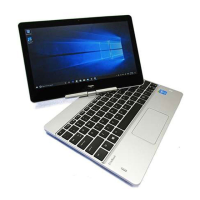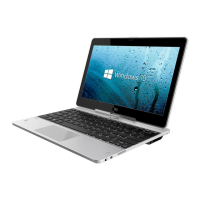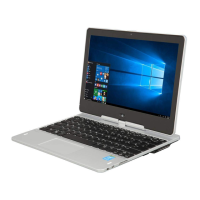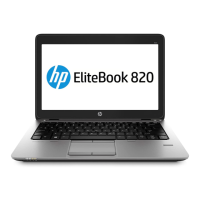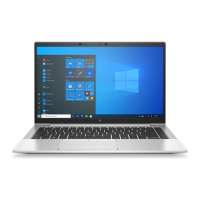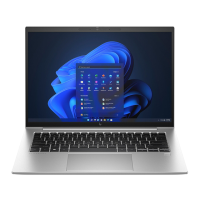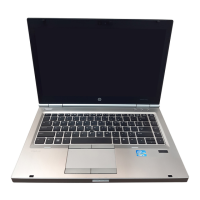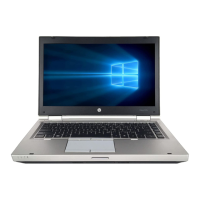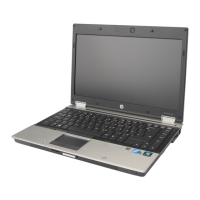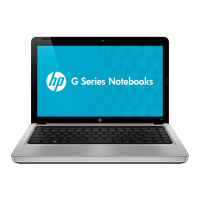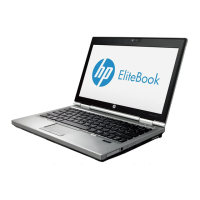Do you have a question about the HP EliteBook Revolve 810 G1 and is the answer not in the manual?
Details on display components including WLAN antennas, ambient light sensor, microphones, and webcam.
Identification of keys, function keys, numeric keypad, and application keys.
Description of indicator lights for Caps Lock, mute status, wireless activity, and touchpad.
Explanation of touchpad buttons, touchpad zone, and on/off functionality.
Identification of vents and speakers located on the left side of the device.
Details on RJ-45, USB 3.0 ports, security slot, DisplayPort, and power connector.
Identification of power button, power light, rotation lock, volume controls, and ports.
Identification of service cover, vents, NFC antenna, and battery bay on the bottom.
Visual guide to external display components including antennas, microphones, and webcam.
Identification of keyboard keys, function keys, and touchpad features.
Description of status lights indicating Caps Lock, mute, wireless, and touchpad activity.
Identification of ports and connectors on the rear and right side of the device.
Identification of components located on the bottom of the computer.
Information on product name, serial number, part number, warranty, and model description.
Illustrated breakdown of major internal computer components with part numbers.
Catalog of miscellaneous parts including AC adapters, digitizer pens, and power cords.
An index listing components by their sequential part numbers for easy lookup.
Tools required and service considerations before starting component removal and replacement.
Guidelines for handling computer cables and connectors to prevent damage during service.
Precautions for handling fragile drive components to prevent damage or data loss.
Essential guidelines to prevent electrostatic discharge (ESD) damage to electronic components.
Procedures for safely packaging and transporting electronic components and equipment.
Recommendations for setting up a safe and static-free workstation for servicing.
Introduction to component removal and replacement, including service tag details.
Controls communication between system devices and includes settings for installed hardware.
Steps to enter and navigate the BIOS setup utility using keyboard or pointing device.
Procedure to return all Computer Setup settings to their original factory values.
Information on obtaining and installing BIOS updates for system performance and stability.
Step-by-step instructions for downloading and preparing BIOS update files from HP.
Running diagnostic tests to determine if computer hardware is functioning properly.
Technical specifications including device dimensions, weight, and input power requirements.
Details on operating and non-operating temperature and relative humidity ranges.
Technical details of the display, including dimensions, resolution, brightness, and viewing angle.
Procedures for backing up files, creating system images, and recovery media in Windows 8.
Using Windows recovery tools and Automatic Repair for system restoration in Windows 8.
Utilizing f11 for hard drive recovery and OS reinstallation in Windows 8.
Recovering the system using Windows 8 operating system media.
Using Windows Refresh for quick recovery and Reset to reinstall Windows.
Backup and restore options for individual files, hard drives, and system images in Windows 7.
Creating system repair discs and recovery media using HP Recovery Disc Creator for Windows 7.
Utilizing Windows recovery tools and Startup Repair for system restoration in Windows 7.
Using f11 for hard drive recovery and OS reinstallation in Windows 7.
Recovering the system using Windows 7 operating system DVD.
Mandatory requirements for power cord length, approval, current capacity, and connectors.
Region-specific power cord standards and accredited agency approvals.
Guidelines for proper disposal of batteries and HP's recycling program.
Details on display components including WLAN antennas, ambient light sensor, microphones, and webcam.
Identification of keys, function keys, numeric keypad, and application keys.
Description of indicator lights for Caps Lock, mute status, wireless activity, and touchpad.
Explanation of touchpad buttons, touchpad zone, and on/off functionality.
Identification of vents and speakers located on the left side of the device.
Details on RJ-45, USB 3.0 ports, security slot, DisplayPort, and power connector.
Identification of power button, power light, rotation lock, volume controls, and ports.
Identification of service cover, vents, NFC antenna, and battery bay on the bottom.
Visual guide to external display components including antennas, microphones, and webcam.
Identification of keyboard keys, function keys, and touchpad features.
Description of status lights indicating Caps Lock, mute, wireless, and touchpad activity.
Identification of ports and connectors on the rear and right side of the device.
Identification of components located on the bottom of the computer.
Information on product name, serial number, part number, warranty, and model description.
Illustrated breakdown of major internal computer components with part numbers.
Catalog of miscellaneous parts including AC adapters, digitizer pens, and power cords.
An index listing components by their sequential part numbers for easy lookup.
Tools required and service considerations before starting component removal and replacement.
Guidelines for handling computer cables and connectors to prevent damage during service.
Precautions for handling fragile drive components to prevent damage or data loss.
Essential guidelines to prevent electrostatic discharge (ESD) damage to electronic components.
Procedures for safely packaging and transporting electronic components and equipment.
Recommendations for setting up a safe and static-free workstation for servicing.
Introduction to component removal and replacement, including service tag details.
Controls communication between system devices and includes settings for installed hardware.
Steps to enter and navigate the BIOS setup utility using keyboard or pointing device.
Procedure to return all Computer Setup settings to their original factory values.
Information on obtaining and installing BIOS updates for system performance and stability.
Step-by-step instructions for downloading and preparing BIOS update files from HP.
Running diagnostic tests to determine if computer hardware is functioning properly.
Technical specifications including device dimensions, weight, and input power requirements.
Details on operating and non-operating temperature and relative humidity ranges.
Technical details of the display, including dimensions, resolution, brightness, and viewing angle.
Procedures for backing up files, creating system images, and recovery media in Windows 8.
Using Windows recovery tools and Automatic Repair for system restoration in Windows 8.
Utilizing f11 for hard drive recovery and OS reinstallation in Windows 8.
Recovering the system using Windows 8 operating system media.
Using Windows Refresh for quick recovery and Reset to reinstall Windows.
Backup and restore options for individual files, hard drives, and system images in Windows 7.
Creating system repair discs and recovery media using HP Recovery Disc Creator for Windows 7.
Utilizing Windows recovery tools and Startup Repair for system restoration in Windows 7.
Using f11 for hard drive recovery and OS reinstallation in Windows 7.
Recovering the system using Windows 7 operating system DVD.
Mandatory requirements for power cord length, approval, current capacity, and connectors.
Region-specific power cord standards and accredited agency approvals.
Guidelines for proper disposal of batteries and HP's recycling program.
| Bus type | DMI |
|---|---|
| Stepping | L1 |
| Tjunction | 105 °C |
| Processor code | SR0XH |
| Processor cache | 4 MB |
| Processor cores | 2 |
| System bus rate | 5 GT/s |
| Processor family | Intel® Core™ i7 |
| Processor series | Intel Core i7-3600 Mobile series |
| Processor socket | BGA 1023 |
| Processor threads | 4 |
| Processor codename | Ivy Bridge |
| Motherboard chipset | Intel® QM77 Express |
| Processor frequency | 2.1 GHz |
| Processor cache type | Smart Cache |
| Processor lithography | 22 nm |
| Processor manufacturer | Intel |
| Processor package size | 31 mm |
| Processor front side bus | - MHz |
| PCI Express slots version | 2.0 |
| Processor boost frequency | 3.3 GHz |
| Processor operating modes | 64-bit |
| ECC supported by processor | No |
| PCI Express configurations | 1x8, 1x16, 2x4, 2x8 |
| Supported instruction sets | AVX |
| Thermal Design Power (TDP) | 17 W |
| CPU multiplier (bus/core ratio) | 21 |
| Thermal Monitoring Technologies | Yes |
| Maximum number of PCI Express lanes | 16 |
| Memory slots | 1x SO-DIMM |
| Internal memory | 4 GB |
| Memory clock speed | 1600 MHz |
| Internal memory type | DDR3-SDRAM |
| Maximum internal memory | - GB |
| SSD capacity | The Solid State Drive's storage capacity in Gigabytes. |
| SSD interface | mSATA |
| Storage media | SSD |
| Total storage capacity | 256 GB |
| Compatible memory cards | MicroSD (TransFlash) |
| Number of HDDs installed | 0 |
| Number of SSDs installed | 1 |
| Display diagonal | 11.6 \ |
| Touch technology | Multi-touch |
| Touchscreen type | Capacitive |
| Display resolution | 1366 x 768 pixels |
| Native aspect ratio | 16:9 |
| On-board graphics card ID | 0x166 |
| Discrete graphics card model | Not available |
| On-board graphics card model | Intel® HD Graphics 4000 |
| On-board graphics card family | Intel® HD Graphics |
| On-board graphics card base frequency | 350 MHz |
| On-board graphics card dynamic frequency (max) | 1200 MHz |
| Keyboard layout | - |
| Processor ARK ID | 71258 |
| Audio system | DTS Studio Sound |
| 3G standards | HSPA+ |
| Data network | 3G |
| Wi-Fi standards | 802.11a, 802.11b, 802.11g |
| Headphone connectivity | 3.5 mm |
| USB 2.0 ports quantity | USB 2.0 ports have a data transmission speed of 480 Mbps, and are backwards compatible with USB 1.1 ports. You can connect all kinds of peripheral devices to them. |
| Bundled software | HP ePrint\\r CyberLink MediaSuite\\r HP Page Lift\\r PDF Complete Corporate Edition\\r Adobe Flash Player |
| Operating system installed | Windows 8 Pro |
| Form factor | Convertible (Swivel) |
| Product type | Hybrid (2-in-1) |
| Product color | Silver |
| Country of origin | China |
| Intel Identity Protection Technology version | 1.00 |
| Battery capacity | 44 Wh |
| Battery life (max) | 8.25 h |
| Number of battery cells | 6 |
| AC adapter power | 45 W |
| AC adapter frequency | 50 - 60 Hz |
| AC adapter input voltage | 100 - 240 V |
| Storage temperature (T-T) | -15 - 60 °C |
| Operating temperature (T-T) | 5 - 35 °C |
| Storage relative humidity (H-H) | 10 - 90 % |
| Operating relative humidity (H-H) | 20 - 80 % |
| Sustainability certificates | ENERGY STAR |
| Depth | 285 mm |
|---|---|
| Width | 212 mm |
| Height | 22.2 mm |
| Weight | 1400 g |
